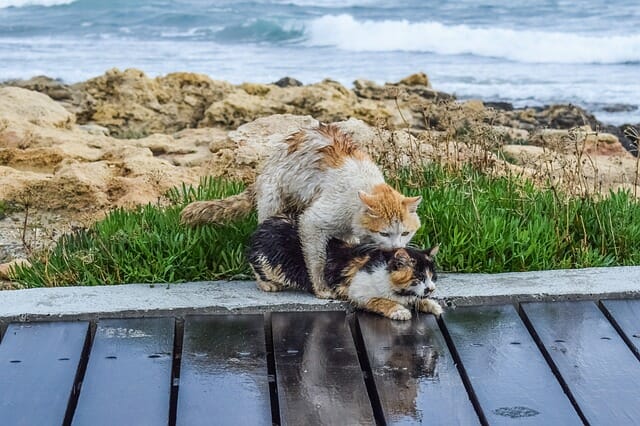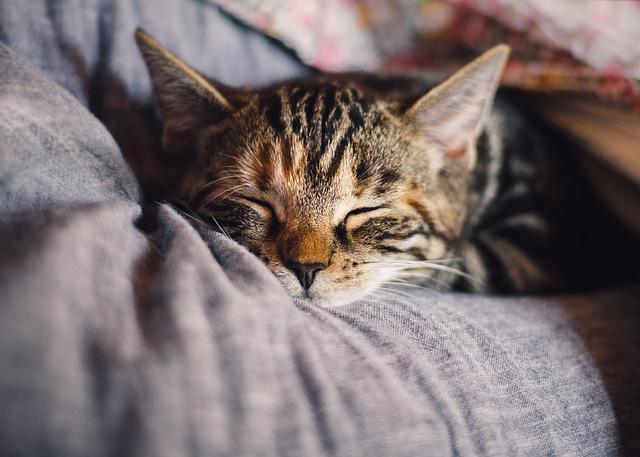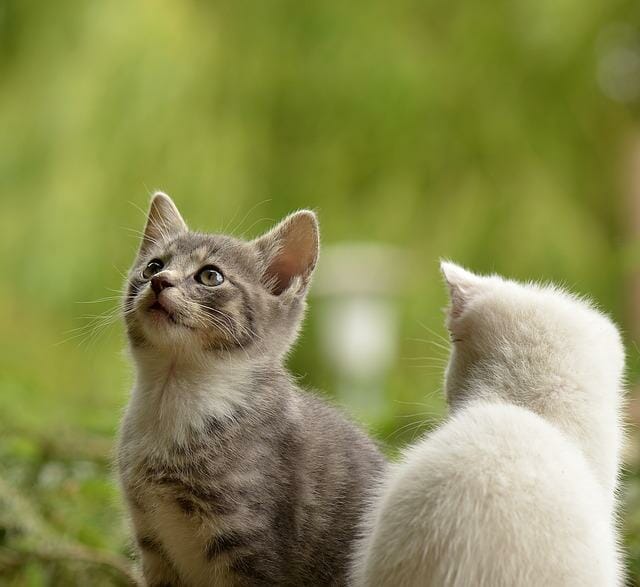When Is Cat Mating Season: Signs of Cats in Heat and How to Deal With It
Cats are seasonally polyestrous, which means they have multiple mating seasons throughout the year. Cats are most likely to go into heat, or estrus, during the spring and fall. However, the exact timing of the mating season can vary depending on several factors, including the cat’s breed, age, health, and environment.


Table of Contents
Signs of a Cat in Heat
Increased Vocalization
One of the common signs of a female cat in heat is increased vocalization. During this time, female cats tend to meow or yowl more frequently and loudly than usual; however, the vocalizations can be persistent and sound distressed, as the cat is trying to attract the attention of male cats.
Hormonal changes during the heat cycle cause increased vocalization. Female cats produce pheromones, chemical signals that attract male cats. The vocalization is the cat’s way of advertising her availability and trying to attract a mate.
Restlessness
Restlessness is another common sign of a female cat in heat, according to the VCA Animal Hospital. During this time, a cat may seem more agitated and restless than usual. She may pace around the house, meow loudly, and display signs of anxiety or distress. Hormonal changes during the heat cycle cause this behavior.
A cat in heat may also exhibit other restless behaviors, such as excessive scratching, digging, or chewing. She may also have trouble sleeping and seem more alert than usual. These behaviors can be disruptive to pet owners, as they can cause damage to furniture and other items in the home.
Low Crawl
Low crawl is a military term that refers to a crawling technique used to move stealthily and avoid detection. It involves crawling on your belly with your body close to the ground and using your elbows and knees to propel yourself forward.
While cats may exhibit behaviors similar to a low crawl, they do not use this technique for the same purpose as military personnel. Instead, cats may crawl low to the ground when they are stalking prey or trying to hide from potential threats. This behavior allows them to move quietly and stay hidden from their prey or predators.
Increased Affection
Increased affection can also signify that a female cat is in heat. During this time, a cat may become more affectionate and seek attention from its owner or other cats in the household. The hormonal changes during the heat cycle cause this behavior.
A cat in heat may rub against furniture, people, or other pets in the household more frequently than usual. She may also purr loudly and seek more physical contact with her owner. While this behavior can be endearing, it can also be disruptive, as a cat in heat may become more demanding and persistent in seeking attention.
Excessive Grooming
Excessive grooming can also indicate that a female cat is in heat. During this time, hormonal changes can cause a cat to groom more frequently than usual. This behavior is a natural response to the physical and emotional stress that comes with the heat cycle.
A cat in heat may spend more time grooming her genital area and other parts of her body. For example, she may lick herself excessively and even pull out patches of hair in some cases. This behavior can be harmful if it leads to skin irritation, infections, or the formation of hairballs.
Loss of Appetite


Loss of appetite can be another sign that a female cat is in heat. During this time, a cat’s hormonal changes can affect her appetite and eating habits. Some cats may lose their appetite entirely, while others may eat less than usual.
If your cat is not eating, monitoring her closely and ensuring she stays hydrated is important. Offer her plenty of fresh water and consider adding wet food to her diet, which can be more appealing and easier to digest. Try feeding her smaller, more frequent meals throughout the day rather than one large meal.
Tips When Dealing With a Cat in Heat
Keep Her Indoors
Keeping your unspayed female cat indoors during her heat cycle is important to prevent her from wandering off searching for a mate. Cats in heat can become very vocal and restless and may try to escape from your home to seek out a male cat. This can put them in danger of getting lost, injured, or involved in fights.
Additionally, allowing your cat to mate during its heat cycle can lead to unwanted breeding and contribute to the overpopulation of cats. Keeping your cat indoors during this time is the safest and most reliable option.
Provide Plenty of Toys and Playtime
Providing your cat with plenty of toys and playtime can help her cope with the behavioral changes during her heat cycle. Cats in heat may become more restless, energetic, and demanding of attention, so it’s important to provide them with plenty of stimulation and playtime to keep them entertained and prevent them from getting bored.
Interactive toys like wand toys and puzzle feeders can help to engage your cat’s hunting instincts and provide mental stimulation. Additionally, providing your cat with a scratching post or cat tree can give her a place to exercise and stretch her muscles, which can help to reduce her anxiety and restlessness.
Try Calming Technique
Calming techniques can help reduce your cat’s anxiety and restlessness during her heat cycle. Some calming techniques you can try include:
- Gentle massage: Gently massaging your cat can help to reduce her stress levels and promote relaxation. Start by stroking her head and neck, then move down her back and sides.
- Aromatherapy: Some scents, such as lavender and chamomile, are known for their calming properties. You can use a diffuser or spray to fill the room with these scents.
- Music: Soft, calming music can help to soothe your cat and reduce her anxiety. You can find music specifically designed for cats online or create a playlist of calming music yourself.
- Calming pheromones: Feline pheromone sprays or diffusers can help to create a calming environment for your cat. These products mimic the natural pheromones that cats release to mark their territory and promote feelings of security and comfort.
Consider Spaying


If you are not planning to breed your cat, spaying her can be a good option to prevent future heat cycles and reduce the risk of certain health issues. Spaying is a surgical procedure that removes the ovaries and uterus of a female cat, making her unable to reproduce.
In addition to preventing heat cycles, spaying can reduce the risk of certain health issues, such as uterine infections and some types of cancer. It can also help to reduce behavior problems associated with heat cycles, such as excessive vocalization and restlessness.
Spaying is typically recommended when a cat is between 4 and 6 months old, although it can be done at any age. Your veterinarian can provide more information about spaying and help you determine if it is the right option for your cat.
Avoid Petting or Handling Her Lower Back
During a cat’s heat cycle, petting or handling its lower back can sometimes cause discomfort or pain. This is because the reproductive organs in a female cat are located in that area and may be swollen or sensitive during this time.
To avoid causing your cat any discomfort, it is best to avoid petting or touching her lower back during her heat cycle. Instead, focus on petting her head and neck, which are areas that most cats enjoy being touched.
If you need to handle your cat for any reason, such as to pick her up or give her medication, try to do so gently and avoid putting pressure on her lower back. For example, consider wearing gloves to protect yourself from accidental scratches or bites if your cat feels particularly agitated or uncomfortable during her heat cycle.
Be Patient
Being patient is also important when dealing with a cat in heat. Cats in heat can be more irritable and vocal than usual and may display unusual behaviors such as spraying urine or pacing around the house. It’s important to understand that these behaviors are normal for a cat in heat and are a natural part of its reproductive cycle.
It’s important to be patient with your cat and provide her with the care and attention she needs during this time. Give her plenty of space and allow her to rest if she seems tired or overwhelmed. Providing plenty of toys and playtime can also help to distract her and provide an outlet for her excess energy.
